This article is more than 5 years old.
Arthur Conan Doyle (1859-1930) was a man of many talents and many interests, but he is best known as the creator of the world’s most famous detective, Sherlock Holmes.
Conan Doyle published his first story in 1879, while he was a medical student at the University of Edinburgh. After completing his studies, Conan Doyle made repeated attempts to establish a medical practice. He was not a great success as a doctor, which had the benefit of giving him plenty of spare time to continue his writing career. By 1891 he had given up medicine entirely and was supporting his family (a wife and two small children) solely by his writing.
Detective fiction was a fairly new genre when Sherlock Holmes made his first appearance in “A Study in Scarlet,” published in Beeton’s Christmas Annual for 1887. A second Holmes story, “The Sign of the Four,” appeared in Lippincott’s Magazine in 1890. Both stories were also published as individual volumes.
But it was the July 1891 publication of “A Scandal in Bohemia” in The Strand magazine that made Sherlock Holmes and Arthur Conan Doyle household names.
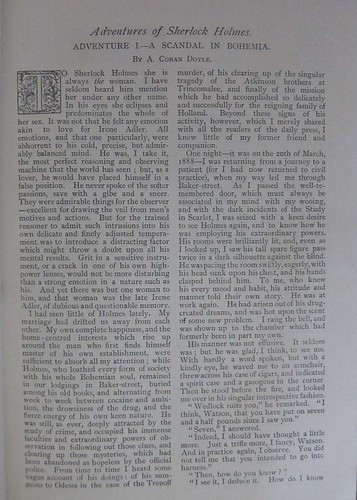
The Strand, a new venture from publisher and entrepreneur George Newnes, was a popular magazine aimed at a middle-class family readership. Its issues included a variety of fiction and nonfiction pieces.
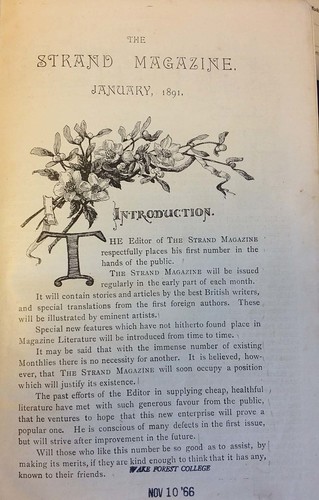
Conan Doyle observed that the “disconnected stories” common in magazines of the time did not particularly inspire reader loyalty. But an ongoing serial story presented problems of its own: readers who missed one issue might lose the plot and become uninterested. Conan Doyle posited that
Clearly the ideal compromise was a character which carried through, and yet instalments [sic.] which were each complete in themselves, so that the purchaser was always sure that he could relish the whole contents of the magazine. I believe that I was the first to realize this, and “The Strand Magazine” the first to put it into practice. . . . Looking round for my central character I felt that Sherlock Holmes, whom I had already handled in two little books, would easily lend himself to a succession of short stories. [Memories and Adventures, 90]
Strand editor Greenhough Smith agreed, and he requested a series of six Sherlock Holmes stories. They were hugely popular and were a major factor in the new magazine’s becoming highly successful. The stories were published in The Strand between July 1891 and June 1892. Immediately thereafter they were reprinted as a separate volume entitled The Adventures of Sherlock Holmes.
The book was a large volume, bound in bright blue with prominent gold lettering and an illustration that was a facsimile of a Strand Magazine cover. It was clearly intended to catch the eye of a potential buyer scanning a bookseller’s stalls, and to reinforce the connection with the magazine.
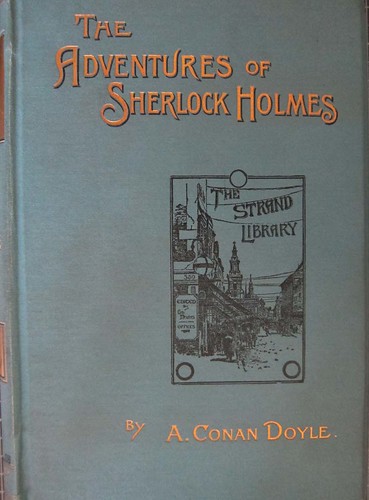
The book version included the illustrations created by Sidney Paget for the magazine installments. Conan Doyle approved of the illustrations, although he initially thought that Paget had made Sherlock Holmes a bit too handsome. It was Paget who created the now-iconic image of Holmes in his long coat and deerstalker hat.
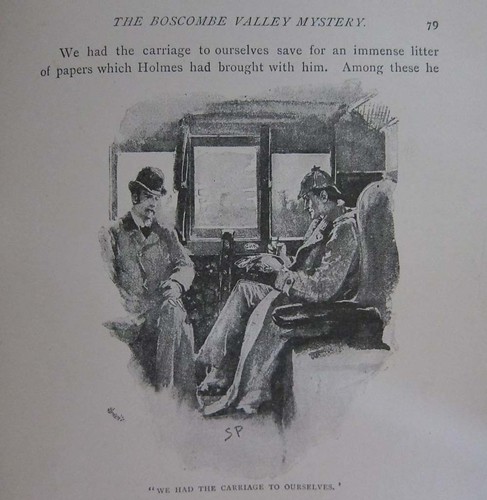
The publication of The Adventures of Sherlock Holmes established Conan Doyle as an author of note. In an interview in The Bookman (May 1892) he was asked “how on earth he had evolved, apparently out of his inner consciousness, such an extraordinary person as his detective Sherlock Holmes.” Conan Doyle replied that
[I]f you please, he is not evolved out of any one’s inner consciousness. Sherlock Holmes is the literary embodiment. . . of my memory of a professor of medicine at Edinburgh University [Dr. Joesph Bell], who would sit in the patients’ waiting-room. . . and diagnose the people as they came in, before they had even opened their mouths. He would tell them their symptoms, he would give them details of their lives, and he would hardly ever make a mistake. [“A Talk with Dr. Conan Doyle”, 50]

Dr. Bell himself, the model for Sherlock Holmes, reviewed The Adventures of Sherlock Holmes for The Bookman (December 1892). Bell praised Conan Doyle’s skill as an author and confirmed the link between the diagnostician and the detective:
The precise and intelligent recognition and appreciation of minor differences is the real essential factor in all successful medical diagnosis. Carried into ordinary life, granted the presence of an insatiable curiosity and fairly acute senses, you have Sherlock Holmes as he astonishes his somewhat dense friend Watson; carried out in a specialised training, you have Sherlock Holmes the skilled detective. [79]
Bell also noted that the stories had been collected in a “handsome volume,” but he observed that “Had the handsome volume been divided into two, it would not have been so heavy to hold.” [81]
Bell was not the only reviewer to remark on the physical appearance of The Adventures of Sherlock Holmes. A less sympathetic writer for the National Observer and British Review (29 October 1892) published an “interview” with Sherlock Holmes himself, in which the fictional detective is highly critical of his creator. Conan Doyle in this account is a money-grubbing hack, “a man of few scruples. . . striving, like all his class, to make ‘copy’ where he can.” And Holmes deduces this from looking at a copy of The Adventures:
You see this book is large and expensively brought out; moreover it is issued by a publisher who caters for the million. Hence it is clear that a very large sale is anticipated. Why? Because the book is supposed to contain a popular element, and that popular element is myself. Now, it follows that Dr. Doyle must have heard of me, through Watson or the police; that he saw I should suit his game (which was money); and having invented spurious stories about me that he hit upon a publisher similarly unscrupulous. [606-607]
The huge popularity of the Sherlock Holmes books provoked something of a backlash from critics like the one from the National Observer. The late 19th century saw a deluge of books and magazines like The Strand which were aimed at a middle and working-class readership who had more leisure time and disposable income than previous generations. The literary elite was alarmed by this incursion of commerce into the realm of art. And Arthur Conan Doyle himself was not immune to this view. Although he was entirely unapologetic about writing for a popular audience, he also had no illusions about the Sherlock Holmes stories being taken seriously as literature. Conan Doyle was far more invested in his works of historical fiction (and later nonfiction histories), telling his Bookman interviewer “That is the only work I really fancy.”
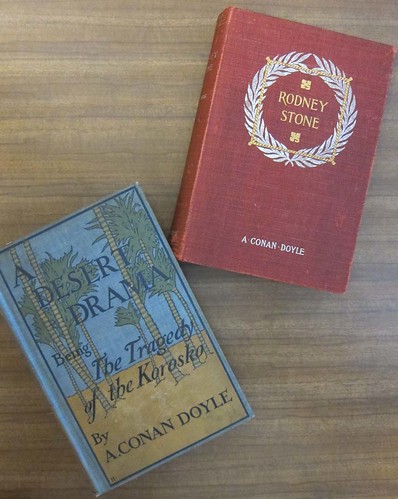
After the great success of The Adventures of Sherlock Holmes, Conan Doyle wrote a second series of Holmes stories for The Strand. Twelve stories appeared between December 1892 and December 1893. The were collected into a volume called The Memoirs of Sherlock Holmes, published in January 1894.
Conan Doyle intended this to be Sherlock Holmes’s last outing. In the last story, “The Final Problem,” Holmes and his arch-nemesis James Moriarty plunge to their apparent deaths over the Reichenbach Falls (Conan Doyle got the idea during a family holiday in the Alps).
Sherlock Holmes fans were outraged. “They say that a man is never properly appreciated until he is dead,” Conan Doyle later observed, “and the general protest against my summary execution of Holmes taught me how many and how numerous were his friends.” [Memories and Adventures, 94]
Conan Doyle eventually relented, publishing “The Hound of the Baskervilles” (which supposedly took place before Holmes’s death) in 1901, and finally bringing Holmes back to life (apparently he had faked his fatal plunge over the falls) in 1903. Conan Doyle published more than 30 additional Sherlock Holmes stories before his own death in 1930.
Over a century later, Sherlock Holmes is still the most famous detective in the world. The audience for the original stories and for new adaptations is as enthusiastic today as it was in the 19th century. It would appear that Sherlock Holmes really is immortal.
The Z. Smith Reynolds Library Special Collections copies of the first editions of The Adventures of Sherlock Holmes and The Memoirs of Sherlock Holmes are from the library of Charles Babcock.

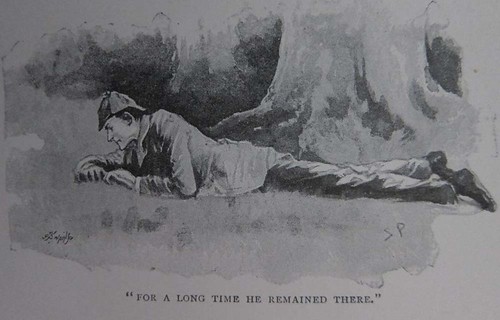

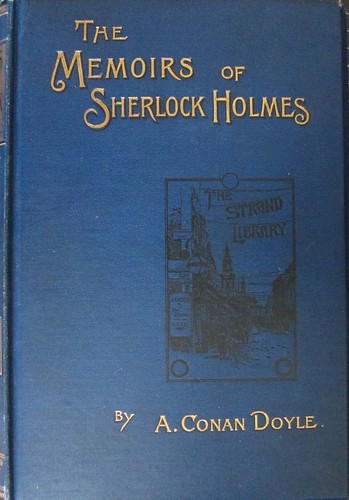

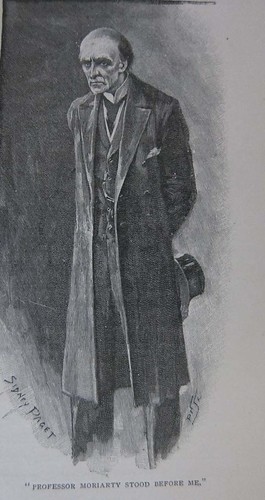
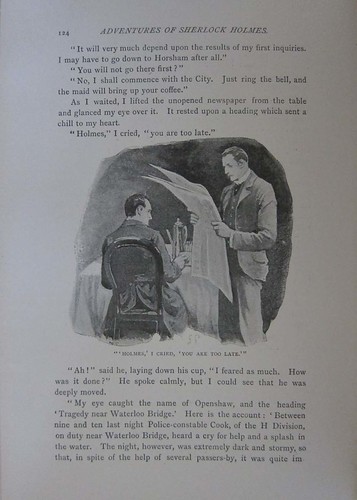
3 Comments on ‘The Adventures of Sherlock Holmes, by Arthur Conan Doyle (1892)’
I saw these volumes when I was working at off-site. They really are a treasure. Thanks for sharing this, Megan.
Excellently told and very timely!
Now I want to start re-reading all of these stories!